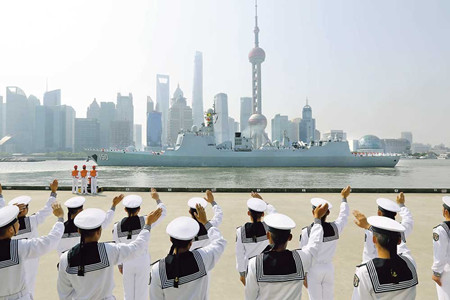Golez: This modest Chinese naval flotilla is not even close to America's "Great White Fleet" consisting of 16 battleships that circumnavigated the world in 1908-1909 during the presidency of US President Teddy Roosevelt to herald America's rise as a world naval power, but it is no doubt part of the "China Dream" to become the world's hegemon by 2049:
"The visiting fleet from Shanghai, composed of missile destroyer Changchun, missile frigate Jingzhou and supply ship Chaohu, will tour Asia, Europe, Africa and Oceania in a trip lasting nearly 180 days, the Xinhua News Agency reported.
"The visits will convey friendship, deepen military communication and cooperation and show a good image of the Chinese navy, said Miao Hua, Political Commissar of the navy, who saw the fleet off. All three ships were domestically built, and this is the maiden overseas voyage of the Jingzhou, commissioned in 2016. The other two ships have previously conducted many escort, drill and patrol missions."
PLA navy expands mission, protects interest in open seas

Chinese naval ships leaving Shanghai yesterday for visits to over 20 countries. The fleet, comprising missile destroyer Changchun, missile frigate Jingzhou and supply ship Chaohu, will tour Asia, Europe, Africa and Oceania for nearly six months. (Photo/Shanghai Daily)
The Chinese navy has expanded its capability to not only safeguard the country's coastal areas, but also to secure China's interests in the open seas, 68 years after the establishment of the People's Liberation Army (PLA) navy, experts said.
Sunday marked the anniversary of the establishment of the navy. A fleet of three Chinese naval ships left Shanghai in the morning for a friendly visit to more than 20 countries.
With the expansion of foreign trade, as well as China's One Belt and One Road initiative, the Chinese navy has taken on a new mission, which is to protect the country's overseas interests.
As a consequence, China's military strategy for the navy has changed and it must increase its presence overseas to meet the new requirements, military expert Song Zhongping said.
As a signature achievement of the navy, the Liaoning aircraft carrier has gained in combat capability and finished its blue sea training, and the country's first domestically built carrier is also expected to be launched soon.
The visiting fleet from Shanghai, composed of missile destroyer Changchun, missile frigate Jingzhou and supply ship Chaohu, will tour Asia, Europe, Africa and Oceania in a trip lasting nearly 180 days, the Xinhua News Agency reported.
The visits will convey friendship, deepen military communication and cooperation and show a good image of the Chinese navy, said Miao Hua, Political Commissar of the navy, who saw the fleet off. All three ships were domestically built, and this is the maiden overseas voyage of the Jingzhou, commissioned in 2016. The other two ships have previously conducted many escort, drill and patrol missions.
Aside from friendly communication with other countries, the overseas visits will provide a valuable opportunity for the navy to learn sea conditions and environments in different parts of the world, so the fleet's officers and sailors will be better prepared for future missions like search and rescue, evacuation, and anti-piracy, an anonymous former PLA navy officer told the Global Times.
According to the latest white paper China's Military Strategy released by the Information Office of the State Council on May 26, 2015, the navy would be shifting its focus from "near-shore defense" to a combined strategy of "near-shore defense" and "open seas protection," and is building a multi-functional and efficient marine combat force structure.
The navy will enhance its capabilities for strategic deterrence and counterattack, maritime maneuvers, joint operations at sea, comprehensive defense and comprehensive support.
"Today, the navy has realized the strategic transformation to 'open seas protection,'" said Zhang Junshe, a senior research fellow at the PLA Naval Military Studies Research Institute.
'Offshore waters' and 'open seas'
"Near-shore defense" means defense in areas close to China's land territory like the South China Sea, Taiwan Strait and the Diaoyu Islands, and in order to meet this requirement, the navy has to gain an overwhelming advantage at least within the first island chain," Xu Guangyu, a senior advisor to the China Arms Control and Disarmament Association, told the Global Times.
"However, we can never say we are fully prepared for a military resolution to the Taiwan question," Song said.
A victory is without question if the PLA only deals with Taiwan's military, but it will have to take US and Japanese intervention into consideration, he said. China should always unremittingly improve its capability to keep foreign military intervention away from Taiwan.
"Open seas defense" means protecting China's overseas interests, including Chinese personnel, projects, investment and trade routes. In recent years, the navy has proved it can successfully execute overseas missions like anti-piracy protection in the Gulf of Aden and evacuations from Libya and Yemen," said Li Jie, a Beijing-based naval expert.
It is necessary for China to develop a modern maritime military force structure commensurate with its national security and development interests, safeguard its national sovereignty and maritime rights and interests, protect the security of strategic sea lines of communication and overseas interests, and participate in international maritime cooperation, so as to provide strategic support for building itself into a maritime power, the white paper said.
In addition, the navy also bears the highly important duty of securing the country's second nuclear strike capability, Song said. "China's new-generation ballistic missile submarine is now under construction and will be launched soon."
In addition, China's ambition to build a powerful navy will also boost the economy, as the navy is a technology-intensive corps and will push the improvement in scientific research, Song said.
No comments:
Post a Comment